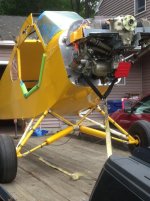I’m in the process of fitting a Trig TT21 to my 12 and wondering where other folks have fitted the transponder antenna and what kind/size of ground plane works best?
The Trig book describes a square ground plane of minimum 120mm to “max” 700mm sides, the smaller size would allow one of the underneath panels to be used, but the larger size sounds like a plate and I’m guessing with a bend to fit the belly contours.
Thanks and happy holidays!!
Philly
Sent from my iPhone using SuperCub.Org mobile app
The Trig book describes a square ground plane of minimum 120mm to “max” 700mm sides, the smaller size would allow one of the underneath panels to be used, but the larger size sounds like a plate and I’m guessing with a bend to fit the belly contours.
Thanks and happy holidays!!
Philly
Sent from my iPhone using SuperCub.Org mobile app





















